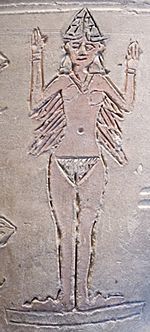
Back in the early eighth century, the Venerable Bede, also known as the father of English history, wrote an essay he called De temporibus: “a little book about the fleeting and wave-tossed course of time.” He pointed out that, in the olden days, the English people used the word Eosturmonath for April, “after a goddess of theirs named Eostre, in whose honor feasts were celebrated.” Eostre, the dawn goddess, came up in the east; her festival was synched with the equinox.
The tradition is older than that. Centuries before Bede, the first historians wrote about the equinox festivals of the goddess Inanna, later known as Ishtar, in the Near East. Temples dedicated to Inanna swarmed with castrates and slaves; but Inanna was fertile, and so were her loves. She hooked up with Enmerkar, the king of Uruk; and later on, she hooked up with Shulgi, or Culgi, the Ur III king. One of the oldest pieces of prose on earth says something like this: “When he has intercourse with me like choice beer, when he ruffles my pubic hair for me, when he plays with the hair of my head, when he lays his hands on my holy genitals, when he lies down on my sweet womb, when he treats me tenderly on the bed, then I will too treat my lord tenderly.”
The Song of Solomon kept on that riff. “O that you would kiss me with the kisses of your mouth! For your love is better than wine,” it began. Kings of Israel, like kings everywhere else, were prolific. Solomon wrote about maidens without number, and is supposed to have kept a thousand women at home; his dad, David, put a few love songs of his own in the Psalms; and his son, Rehoboam, left 88 children behind (Song of Solomon 1:2, 6:8; Psalms 45:14; 1 Kings 11:3; 2 Chronicles 11:21). Some people are breeders.
But some people are not. Just this month, the critical edition of a tiny, 4 x 8 centimeter strip of papyrus, dated to within a few centuries of Jesus’ death, came out. Lines 4-5 of The Gospel of Jesus’ Wife read like this: “Jesus said to them, ‘My wife….She is able to be my disciple’.” Everybody knows that St Peter, the first pope, had a mother-in-law; and some have argued that St Paul, who refers to his true yokefellow, might have had a wife (Matthew 8:14; Luke 4:38; Philippians 4:3). But the consensus is that Jesus never married--that strip of papyrus aside.
Bede wasn’t a breeder, either. Back in 731, when he finished his classic Historia ecclesiastica gentis Anglorum: a history of the English church and people, he ended with a short autobiographical note. “I was born on the lands of this monastery, and on reaching seven years of age, I was entrusted by my family first to the most reverend abbot Benedict and later to abbot Ceolfrid for my education. I have spent all the remainder of my life in this monastery and devoted myself entirely to study.” He wasn’t alone. Abbot Benedict had founded his monastery with just 17 monks, but within a generation there were 600 of them. “He refused to bring forth children in the flesh, being predestined to Christ to raise up for him sons nurtured in spiritual doctrine who would live forever in the world to come.”
Just over a hundred years ago, the word estrus was first used to refer to the rutting of animals, or heat. According to etymologists, like Barnhart, it connoted “passion or frenzy, as if brought on by a stinging or goading;” and it borrowed from the Latin word oestrus, or “frenzy, gadfly,” and from the Greek word oîstros, or “gadfly, breeze, sting, mad impulse.” All of which sounds suspiciously like Eostre, or Ishtar, to me.
What does it all mean? It means that once upon a time, the equinox was a grand time for kings. And that for centuries after that, it was written about by unmarried monks. But that in these democratic days, everybody gets an egg. Hip hop! Happy Easter! Enjoy your rabbits.
COINCIDENCE:
References
Bede. The Reckoning of Time and History of the English Church and People, translated by J. A. Giles. London: Whittaker, 1843.
Kramer, Samuel Noah. The Sacred Marriage Rite. Bloomington: Indiana University Press, 1969.
Betzig, Laura. 2014a. Eusociality: From the first foragers to the first states. Human Nature, 25: 1-5.
Betzig, Laura. 2014b. Eusociality in history. Human Nature, 25: 80-99.


